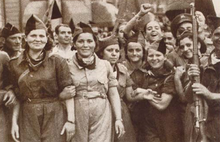Milicianas in the Spanish Civil War
The Dictatorship of Primo de Rivera saw women take more to the streets to protest and riot, though their actions were dismissed by male political leaders.
While women had been sporadically involved in combat in Spain, no large organized force of female fighters (Spanish: miliciana) had been mobilized in the prelude to the Second Republic.
[1][2][3] Notable women who had participated in the past included Napoleon resistance fighter Agustina de Aragón, Manuela Malasaña and Clara del Rey during the Peninsular War.
[1] During the Peninsular War, a writer for the La Gaceta de Madrid would ask why the city's women fighters exceeded their men in courage.
[6] Existing tensions within the anarchist movement, as a result of deliberate exclusion or discouragement by male leadership, eventually led to the creation of Mujeres Libres by Lucía Sánchez Saornil, Mercedes Comaposada and Amparo Poch y Gascón in May 1936, shortly before the start of the Civil War.
[14] The actions of women attached to Asociación de Mujeres contra la Guerra y el Fascismo in the event led to the organization being declared illegal later in the year.
[13] Imagery from the conflict was subsequently used by both sides for propaganda to further their own agenda, particularly inside PSOE who saw it the situation as a call for political unity on the left if they were to have any hope of countering the rise of fascism in Spain.
Right wing propaganda at the time featured women as vicious killers, who defied gender norms to eliminate the idea of Spanish motherhood.
With the Republic largely maintaining control over its Navy, Franco and others in the military successfully convinced Adolf Hitler to provide transport for Spanish troops from North Africa to the Iberian peninsula.
[13][17] Franco's initial coalition included monarchists, conservative Republicans, Falange Española members, Carlist traditionalist, Roman Catholic clergy and the Spanish army.
"[20] At the start of the Civil War, there were two primary anarchist organizations: Confederación Nacional del Trabajo (CNT) and the Federación Anarquista Ibérica (FAI).
[1][21] Asociación de Mujeres contra la Guerra y el Fascismo underwent a second name change in 1936, shortly after the start of the Civil War.
[6] While the national branches of Communist Party supported sending foreign fighters to Spain to fight in the Civil War in the International Brigades, they often opposed their female members from going.
[2] In some cases, milicianas were told by column leaders that they were only allowed to remain on the front in support roles for men, by doing working as nurses or teaching largely illiterate militiamen to read.
[23] In the last half of 1936, milicianas were not considered exceptional by many of their male colleagues; they served as comrades alongside men in separate or mixed gender battalions.
[1][21][35] This was in large part because many of the milicianas were motivated to fight because their own revolutionary beliefs: they believed their involvement could change the course of the war, and bring about a new revolution in thinking in society.
[6] Lina Ódena, Soledad Casilda Méndez, Aída Lafuente, Rosario Sánchez Mora, Concha Lozano and Maruja Tomico were all milicianas who would be immortalized by the Republic during this period of active women's involvement in combat.
The start of the war led to the cancellation of the event, with a number of the participants enlisting in support of the Republic and being involved in the July 1936 defense of Barcelona.
[27] Concha Pérez Collado was part of Los Aguiluchos de Les Corts, a group of 100 armed soldiers from her Barcelona neighborhood, who joined shortly after the outbreak of the war.
[33][42] Lois Orr served in Workers' Party of Marxist Unification (POUM) female militia in Barcelona in the early part of the war.
[2] In the first days of the war, Trinidad Revoltó Cervelló was involved in front line combat at the Military Headquarters and at the Atarazanas Barracks in Barcelona.
[45][46] She told her boyfriend shortly after enlisting, ”At Pedralbes, in the Miguel Bakunin barracks, a column is forming to go to the Aragon front, and I have enrolled as a volunteer”.
[2] By this time, Unión de Muchachas was a communist organized rearguard women's only battalion in Madrid that fought on the front line starting on 8 November 1936.
A crackdown occurred as a consequence of the event, and Thalmann and her future husband went underground, but were later captured by Servicio de Información Militar (SIM) while trying to flee by boat from Barcelona.
[58] Foreign observers covering the war often wrote about women's bravery on the front, including saying they took enemy fire better than many of the men they fought alongside.
What is most likely is that various political and military leaders made their own decisions based on their own beliefs that led to different groups of female combatants gradually being withdrawn from the front.
They viewed this decision as part of a larger symptom of problems for women in society, and did not want to return to the traditional gender roles from which they had used the war to escape.
To some degree, the image in Republican propaganda was one that many milicianas identified with and were complicit in sharing as they had absorbed cultural gender norms in their youth that they continued to perpetuate.
She was modest, pure, asexual, self-sacrificing and traditional, supporting the Spanish family through work at home, She was the anti-thesis of the Republican fighter in that she was far away from the front and would never be involved in combat.
One of the main topics they focused on was often inequality on the front, and the expectation that in addition to combat, they would also do support roles like tending to the injured, cooking and cleaning while male colleagues were afforded time to rest.

















